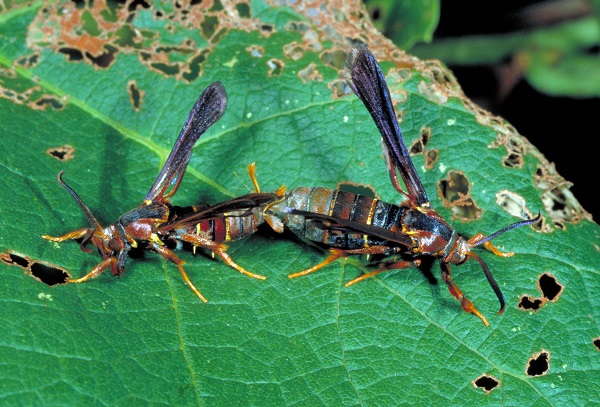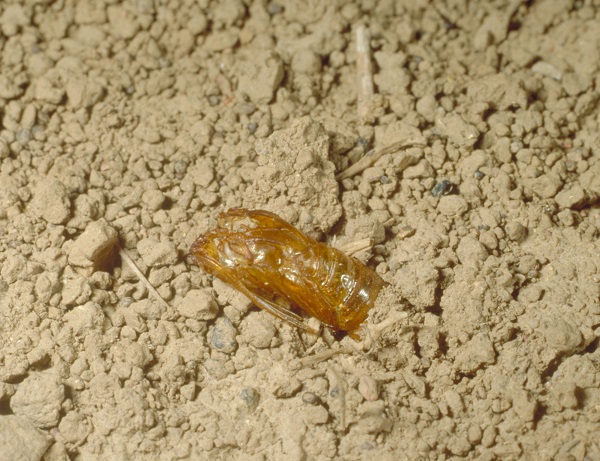Grape Root Borer
ENTFACT-220: Grape Root Borer | Download PDF
by Ric Bessin, Extension Specialist, and John Hartman, Extension Plant Pathologist
University of Kentucky College of Agriculture
Grape root borer (GRB) is potentially the most destructive insect attacking grapes in Kentucky. Larvae of this insect tunnel into the larger roots and crown of vines below the soil surface. Symptoms of GRB attack include poor vine growth and fruit set, even loss of some vines. Because damage is restricted to below ground, problems often go unnoticed until vine decline is observed. Damage caused by larval feeding can range from just a few feeding sites to complete root system destruction. Multiple GRB in a single plant can result in complete root girdling. GRB is not common with new grape plantings, but problems often begin to develop after several years of grape production. GRB is one pest of grapes that is often ignored until it becomes a serious problem affecting the vineyard.

Figure 1. Mating pair of grape root borer moths.
It takes two years for the GRB to complete its life cycle. Larvae are cylindrical, cream-colored, with three pairs of true legs near the head and five pairs of fleshy abdominal prolegs each bearing two bands of tiny hooks. The larvae are 1-1/2 inch long when mature and have a retractable brown head. Adult moths are active during a period of several weeks. Adults are brown moths with thin yellow bands on the abdomen and resemble some paper wasps. The front wings are brown while hindwings are clear. Male moths fly about in a manner similar to wasps. Generally the moths are active from July through early August.
Eggs are laid on the soil surface, grape leaves, and weeds within eight days of adult emergence. Females lay an average of 350 eggs. Eggs hatch in about two weeks and larvae immediately tunnel into the soil in search of grape roots. About 95% of the larvae die before reaching roots, but less than 1% die after finding grape roots. The larvae spend 22 months feeding in the roots. During the summer of the second year, larvae will pupate near the soil surface.
Monitoring
Injury by GRB is often most severe in low, poorly drained areas of the vineyard. In mid-summer, growers should examine around the bases of vines out to a distance of 18 inches for empty pupal skins of grape root borer.

Figure 2. Grape root borer pupal skin partially visible in soil.
In Kentucky, a control action for GRB is recommended if more than 5 percent of the vines are found to have GRB pupal cases emerging from the soil. If an insecticide is to be used, then it is best to apply the insecticide just as the adults are beginning to emerge, but the preharvest interval may make it necessary to spray after harvest. The insecticide should be applied as a coarse spray to a 15 square foot area surrounding the vine. Treat with an insecticide only if necessary. If GRB is not a problem, there is no reason to risk destroying the natural control processes and increasing production costs.
GRB Management
Good weed management assists with control of GRB. Eliminating weeds around the base of vines reduces the sites for egg laying and improves spray coverage for GRB control. In small plantings and backyard settings, plastic mulch works as an effective barrier around the base of vines, not allowing the GRB larvae to become established. Currently, Lorsban is the only insecticide labeled for control of GRB. This treatment is applied directly to the ground under the grape trellis at least 35 days prior to harvest. Do not allow this spray to contact the fruit or foliage. A final alternative is the use of parasitic nematodes which are applied as a drench to the base of the vines. These move through the soil and can kill the GRB larvae even after they tunnel into the roots.
Revised: 11/19
CAUTION! Pesticide recommendations in this publication are registered for use in Kentucky, USA ONLY! The use of some products may not be legal in your state or country. Please check with your local county agent or regulatory official before using any pesticide mentioned in this publication.
Of course, ALWAYS READ AND FOLLOW LABEL DIRECTIONS FOR SAFE USE OF ANY PESTICIDE!
Photos courtesy Ric Bessin, University of Kentucky Entomology
